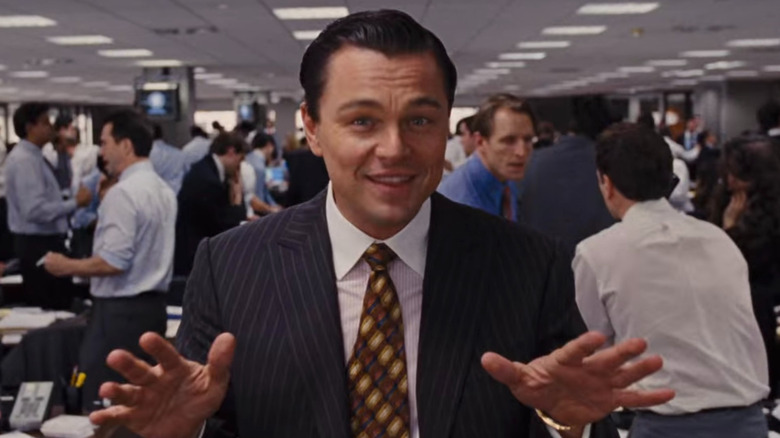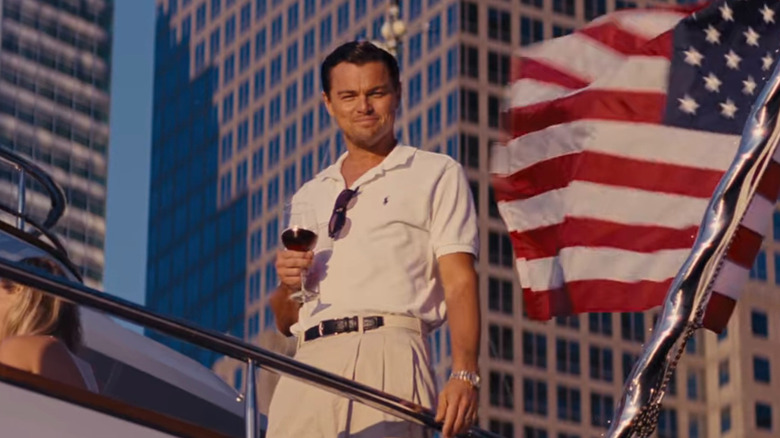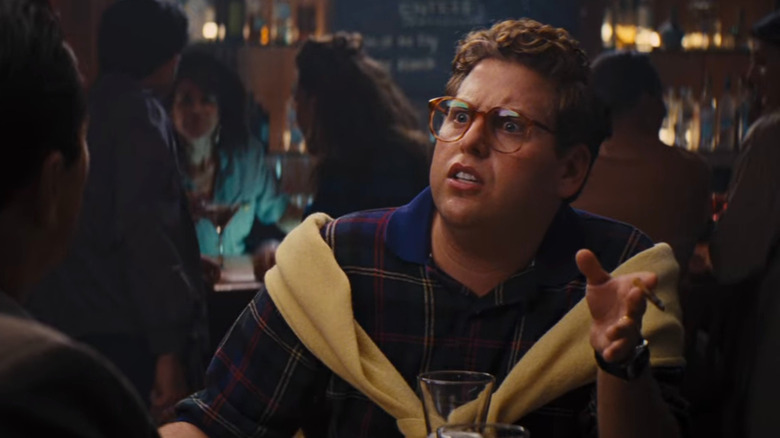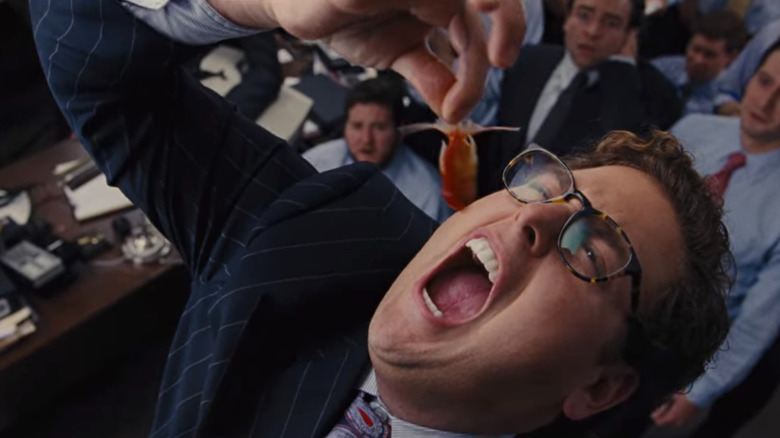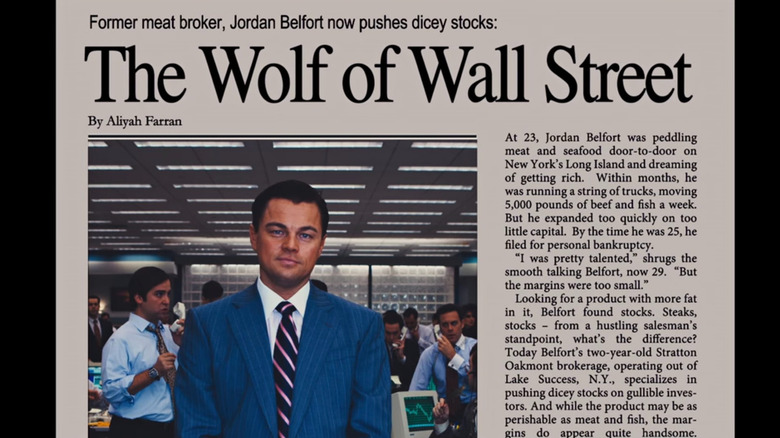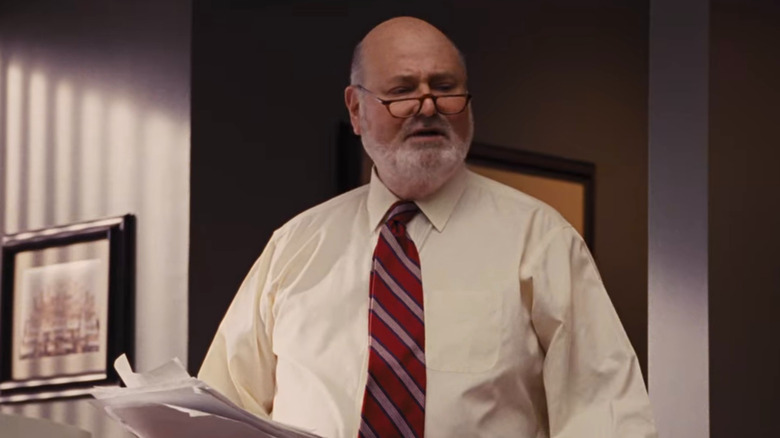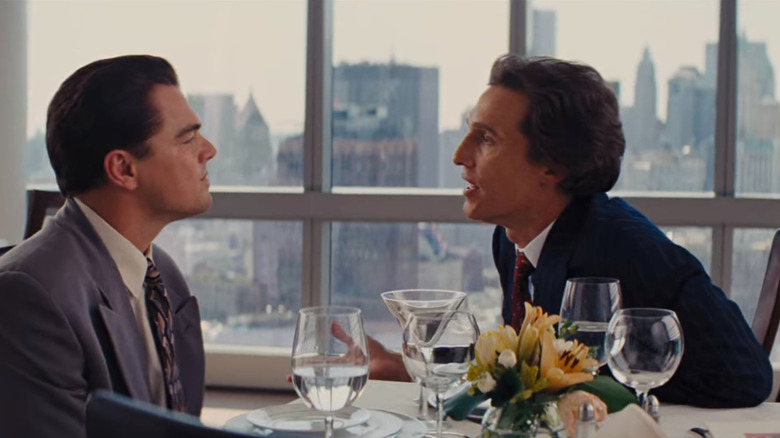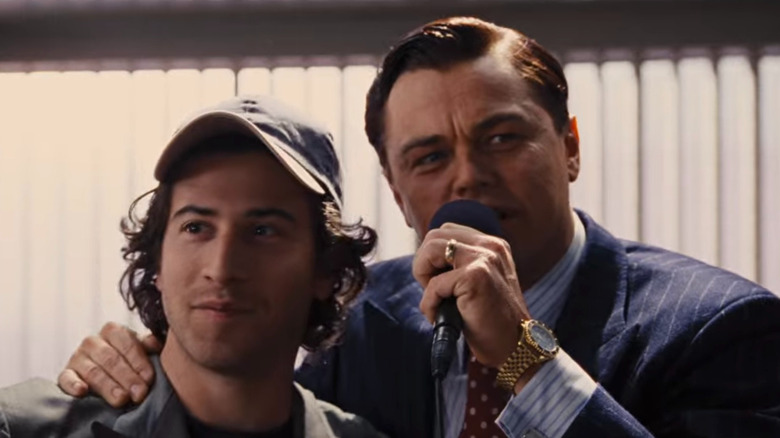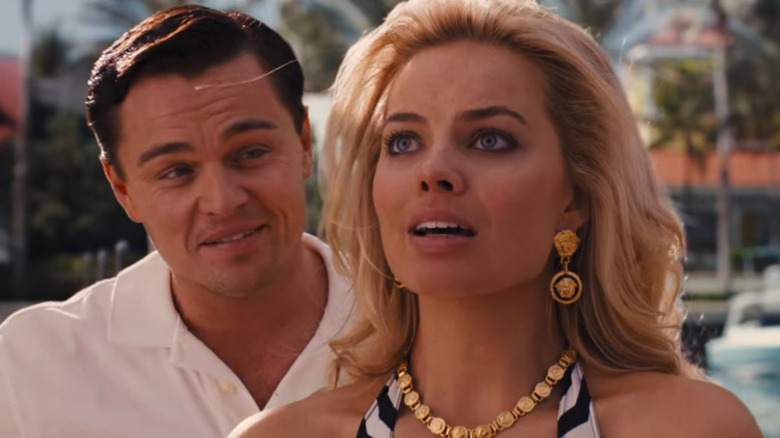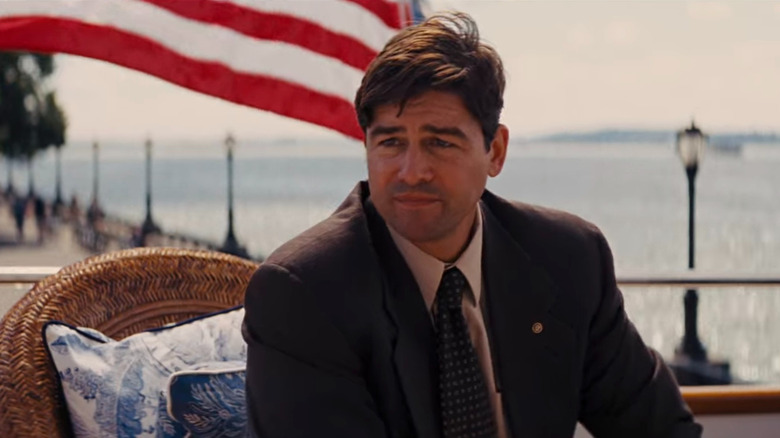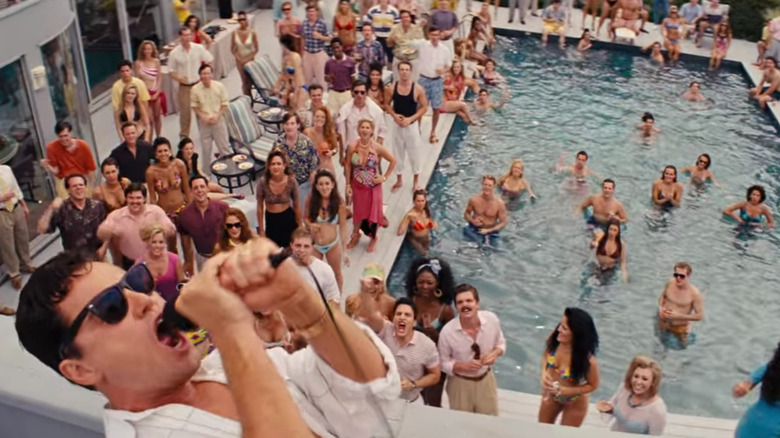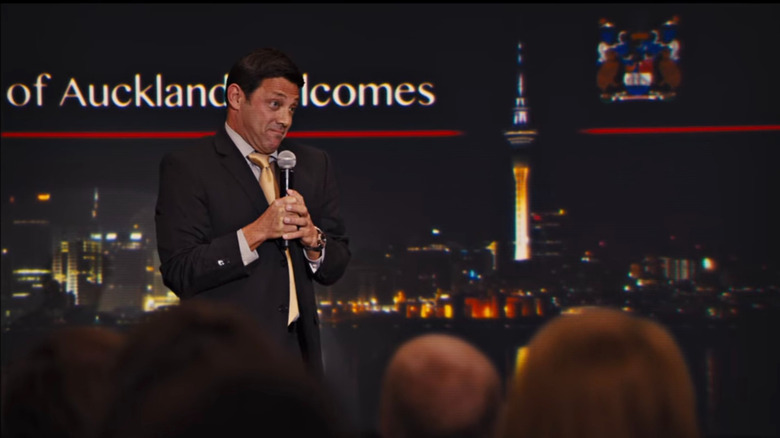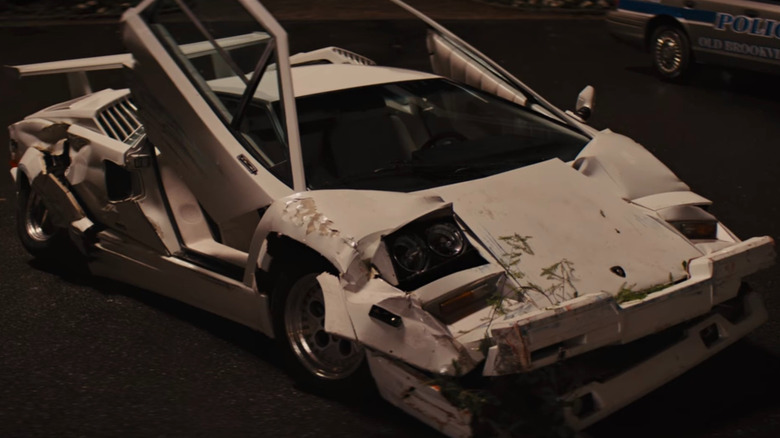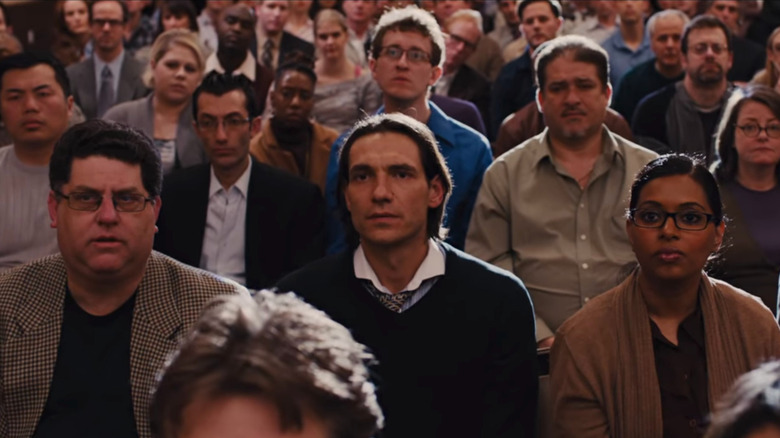The Fascinating True Story Behind The Wolf Of Wall Street
Even before Hollywood came calling, the real-life Jordan Belfort was equating himself to movie villains. Once a stockbroker, then a convict, then a motivational speaker, Belfort wrote of his experiences in his bestselling 2007 memoir, "The Wolf of Wall Street." It contains the line, "I had lots of nicknames. Gordon Gekko, Don Corleone, Keyser Soze; they even called me the King. But my favorite was the Wolf of Wall Street."
Cross-reference those first three alleged nicknames with the films "Wall Street," "The Godfather," and "The Usual Suspects." It soon becomes clear that Belfort, the born salesman, was all too ready to peddle himself as someone who belonged in the pantheon of great movie villains. Luckily for him (less so for the unseen victims of his financial crimes), director Martin Scorsese was happy to oblige him with a star-studded movie adaptation.
Belfort's memoir is filled with many wild stories, but some have questioned the veracity of its self-serving claims. By the time Scorsese came along and turned it into an Oscar-nominated 2013 film, audiences would be one more layer removed from the truth of what happened. The book cover reads, "I partied like a rock star, lived like a king," and inside its pages, Belfort, the "former member of the middle class," speaks in passing of "chaos capitalism."
"The Wolf of Wall Street," the movie, makes good on that dubious vision with a three-hour ode to excess, wealth, and skullduggery that's all the more unbelievable because some of it really occurred.
A conman's sworn (and swearing) testimony
Martin Scorsese, working for the fifth time with Leonardo DiCaprio as his leading man, broke his own Guinness World Record for cinematic use of the f-word with "The Wolf of Wall Street." His film "Casino" had previously set the record in 1995, but "The Wolf of Wall Street" eclipsed its 422 f-bombs with a whopping 506 of them.
That's just one interesting bit of trivia related to the movie. When you sift through all the swearing to get at the facts, though, just how much of "The Wolf of Wall Street" was true, and how much of it was embellishment — or straight fibs of the kind Keyser Soze might tell?
Jordan Belfort is not what you'd call a credible witness; in fact, the whole movie is arguably told from the perspective of a master of deceit, who scammed investors out of millions. Scorsese leveraged all his cinematic powers in service of what DiCaprio called "a modern-day Caligula" story, but he was also adapting a criminal's autobiography. That's a little different than what he did with "Goodfellas" and the aforementioned "Casino," both adapted from a nonfiction book where the gangster's tale came filtered through author Nicholas Pileggi.
"The Irishman," too, was based on a Charles Brandt book about the life of mob enforcer Frank Sheeran, whose confession was later discredited. In "The Wolf of Wall Street," the bad guy tells his own story, sometimes giving the camera a suitably wolfish grin as he does so.
Jonah Hill's character was based on Danny Porush
Terence Winter handled the screenwriting chores for "The Wolf of Wall Street," and he and Martin Scorsese framed an entire HBO series, "Boardwalk Empire," around another gangster named Nucky Thompson. Actor Bobby Cannavale – who won an Emmy Award for "Boardwalk Empire" the same year "The Wolf of Wall Street" hit theaters — narrated the original, abridged audiobook version of Jordan Belfort's memoir.
In the book, Jonah Hill's character, Donnie Azoff, is referred to by the name Danny Porush. Donnie was loosely based on the real Danny, who was Belfort's business partner and the co-founder of Stratton Oakmont, the Long Island brokerage house that becomes a circus of sex, drugs, dwarf-tossing, and pump-and-dump fraud in "The Wolf of Wall Street."
Though Porush has called Belfort's book "a distant relative of the truth," he himself married a not-so-distant relative: his own first cousin. In the movie, Belfort broaches the subject of these "rumors" over beers at a bar, eliciting Donnie's bug-eyed, toothy admission, "Yeah, my wife is my cousin or whatever." That part of Porush's personal background is true, according to Time, though he and his cousin are now divorced.
Unlike Belfort, Porush was not involved in the making of "The Wolf of Wall Street." Changing his character's name helped remove any liability the filmmakers might face for damaging his reputation. Porush reportedly threatened to sue them beforehand, so the name change was a practical decision meant to cover their bases.
What really happened at the office?
On the testosterone-filled office floor in "The Wolf of Wall Street," Jordan Belfort psyches up his stockbrokers with the words, "This right here is the land of opportunity. Stratton Oakmont is America!" It's true he used to give speeches to his employees with a microphone, which prepared him for his later life of motivational speaking. Substitute "country" for "company" in his movie speeches, and it lays bare the cultural subtext of "The Wolf of Wall Street."
In Belfort's America, money can buy anything and everyone. Sex workers were indeed charged to the company credit card, his book indicates, and Danny Porush says it's true they paid an employee $10,000 to shave her head. The movie makes a spectacle out of her doing it to get breast implants, with Belfort shouting, "This is the greatest country company in the world!"
It's not long before a half-dressed band comes marching in, followed by champagne waiters and strippers. Martin Scorsese dials everything up to 11, combining Belfort's book description of multiple parties into one hedonistic scene.
In an interview with Mother Jones (by way of History vs. Hollywood), Porush disputed that the office ever brought in a chimpanzee on roller skates or did any dwarf-tossing at its parties. Little people are said to have attended one party, but Belfort's memoir only depicts the meeting where he and his associates discuss the hypothetical specifics of tossing them. Porush admitted, however, that the part where he/Donnie swallows a broker's pet goldfish was true.
Forbes really did profile Belfort
In "The Wolf of Wall Street," there's a scene where a journalist for Forbes magazine visits the offices of Stratton Oakmont. She's doing a profile on Jordan Belfort, which winds up being "a total f***ing hatchet job" in his eyes. The article appears onscreen with Leonardo DiCaprio in his tan-faced movie poster pose below the headline "The Wolf of Wall Street." All the while, Belfort rails against the journalist labeling him that, as if she was the one who coined his nickname and the movie's title.
You can read the real 1991 article on the official Forbes site (and see a larger scanned image of it here). The headline was actually "Steaks, Stocks — What's The Difference?" This is one of the more interesting "Wolf of Wall Street" artifacts out there, showing how the movie partially overlaps with reality. It's a "prop" anyone can access online, and it offers a real view of how someone other than Jordan Belfort viewed Jordan Belfort.
The true journalist was Roula Khalaf, not Aliyah Farran (the fictitious byline shown in the movie), though her article does contain the highlighted movie phrase "pushing dicey stocks." It also contains a line that DiCaprio performs almost verbatim about Belfort "sounding like a kind of twisted Robin Hood, who takes from the rich and gives to himself and his merry band of brokers." Yet if it wasn't Forbes that coined the "Wolf of Wall Street" nickname, that immediately opens up the question of who did.
Was Belfort ever actually called The Wolf of Wall Street?
According to CNN, Jordan Belfort himself came up with the "Wolf of Wall Street" name. Before Martin Scorsese's film premiered, Danny Porush disputed that anyone at Stratton Oakmont ever called Belfort that. In 2013, a prosecutor in the Belfort case, former assistant U.S. attorney Joel M. Cohen, likewise told The New York Times, "In all the years that we investigated him, the hundreds of hours I spent with him and his cohorts, I never heard anyone call him 'The Wolf of Wall Street.'"
Circling back to Belfort's sketchy book claim that "Gordon Gekko, Don Corleone, Keyser Soze" were among his many nicknames, he had already lumped himself together with several cinematic bad boys. By linking his name to famous movie villains, it's as if Belfort aimed to set himself up as a sort of prepackaged Hollywood deal. "I was the ultimate wolf in sheep's clothing," he writes.
There's a part in the book where Belfort's apoplectic father, played by Rob Reiner in the movie, rattles off a whole paragraph of dialogue, which begins with, "And you, the so-called Wolf of Wall Street — the demented young Wolf!" Unless he was running a tape recorder in his office back in the 1990s, it seems unlikely Belfort would have been able to perfectly recollect such dialogue. It would appear that, rather than being incensed at his lupine nickname, Belfort anointed himself the Wolf of Wall Street as a bit of self-promotion.
What Belfort did before becoming a stockbroker
"The Wolf of Wall Street" begins with Jordan Belfort already relishing a rich and famous lifestyle. It then flashes back to him at 22, getting off the bus on Wall Street, "the one place on earth that befit [his] high-minded ambitions."
The truth is, Wall Street came a little later for Belfort. In the movie, he mentions being "raised by two accountants." Yet there's no mention of him dropping out of dentistry school (per The Independent) or selling meat and seafood door-to-door. The latter is what prompted the wordplay in the Forbes headline, "Steaks, Stocks — What's The Difference?" Belfort's beefy business soon went under, leaving him a failed businessman at 25. It was only then that he became a stockbroker-in-training at the firm L.F. Rothschild.
Matthew McConaughey's character, Mark Hanna, was a real senior broker at L.F. Rothschild who did advise masturbation and cocaine as keys to success, according to Belfort's memoir. In a video on his verified Twitter account, McConaughey said that the character's chest-thumping chant was born of a warm-up ritual that he himself did before every take, just to get in the zone as an actor.
Biography.com reveals that Belfort started selling stocks in 1987. That was the same year future president Donald Trump published his memoir, "The Art of the Deal," while Oliver Stone's aforementioned "Wall Street," with its famous movie quote, "Greed is good," hit theaters nationwide.
Fashion designer Steve Madden was involved
Actor Jake Hoffman, who also appears in "The Irishman" and is Dustin Hoffman's son, plays designer Steve Madden in "The Wolf of Wall Street." Madden and Danny Porush were childhood friends, just as the movie depicts. The company Madden founded (and continues to design for) is still a leading name in women's shoes. In the 2021 fiscal year, its revenue jumped up to $1.9 billion.
The real-life Madden thought Hoffman's portrayal of him was "too nerdy." Though the movie implies he stabbed Jordan Belfort in the back by unloading shares after Stratton Oakmont took his company public, Madden told Page Six, "He ratted me out to save himself."
Madden wouldn't cooperate with the FBI as Belfort did, and wound up serving a longer 41-month sentence in prison (compared to Belfort's 22-month stretch). However, his life rebounded, and he's called "The Wolf of Wall Street" "a great movie." In his autobiography, "The Cobbler," Madden wrote, "The movie also raised our brand awareness with young men and increased our name recognition."
Coco Chanel's yacht went down with Belfort's marriage
When Jordan Belfort is touting Steve Madden's once-in-a-decade genius in "The Wolf of Wall Street," he compares him to other well-known fashion designers. Coco Chanel's name is sandwiched between Gianni Versace and Yves St. Laurent without further comment, but Belfort had a greater real-life connection to Chanel, as he was the last person to own her yacht.
Between the publication and filming of "The Wolf of Wall Street," Chanel's image was tarnished by revelations that she was a Nazi agent. This may be why her previous ownership of the yacht was left out, despite being included in Belfort's memoir. As seen in the movie, he did sink the yacht in a storm, and he did sink his marriage by hitting his wife and driving his car through the garage door with his 3-year-old child in front.
The yacht was named the Nadine, not the Naomi, and the same goes for Belfort's wife. Margot Robbie landed the Naomi part by going off-script and slapping DiCaprio in her improvised audition. She regretted filming their love scene on a cash bed because of all the paper cuts it left her.
The real Nadine, who went on to become a Ph.D. and TikTok-powered therapist after their divorce, said it's not true Belfort bought her the yacht as a wedding present. His abuse of her and his rough helicopter landing on their front lawn was partially fueled by a real drug problem.
Fall of the new Rome
After Jordan Belfort is caught and becomes the Rat of Wall Street, the movie portrays him heroically tipping off Donnie Azoff about him wearing a wire via a napkin message. Belfort never tipped off Danny Porush, but in his sequel book, "Catching the Wolf of Wall Street," he related a similar incident involving another friend.
By likening Belfort to Caligula, Leonardo DiCaprio somewhat aligns "The Wolf of Wall Street" with the idea that America is the new Roman Empire. His decline and fall is its decline and fall. FBI agent Patrick Denham, seen on Belfort's yacht with the American flag almost flowing out of his head, can only try and plug the dam. Kyle Chandler's all-American image as Eric Taylor in "Friday Night Lights" thus underpins Denham's character, who was based on agent Gregory Lockwood.
Former Stratton Oakmont exec Andrew Greene, the inspiration for the toupee-wearing character "Wigwam" in the book and "Rugrat" (P.J. Byrne) in the movie, unsuccessfully sued the studios behind "The Wolf of Wall Street" for libel, losing in part because of the credits disclaimer:
"While this story is based on actual events, certain characters, characterizations, incidents, locations and dialogue were fictionalized or invented for purposes of dramatization. With respect to such fictionalization or invention, any similarity to the name or to the actual character or history of any person, living or dead, or any product or entity or actual incident, is entirely for dramatic purpose and not intended to reflect on an actual character, history, product or entity."
Tommy Chong was Belfort's 'cube mate'
Tommy Chong has dozens of movie and TV credits to his name, some through his collaboration with Cheech Marin in the stoner comedy duo Cheech & Chong. He had a recurring role on "That '70s Show" and has also done activism for marijuana legalization.
As chance would have it, a nine-month sentence for selling bongs online landed Chong in the same federal prison as Jordan Belfort. The prison was so nice that it didn't even have cells, but the two men apparently shared a cubicle. New York Magazine reports that they were "cube mates" or "cubies."
In 2014, Yahoo News further reported that Chong — as Belfort's cube mate — was instrumental in convincing him to turn his life story into a memoir. At the time, Chong was writing his own book, and though Belfort would regale him with stories of his stockbroker misadventures, he had been wiling away his days in prison by playing tennis.
The movie shows Belfort on the tennis court at the end, where he brags about how being rich and living in a country "where everything was for sale" helped soften the blow when he eventually had to face the consequences of his actions.
In prison, Chong gave Belfort some writing advice after the fictionalized first draft of "The Wolf of Wall Street" read like a John Grisham knockoff. "I told him a few tricks of the trade, how to articulate the story," Chong said.
Belfort was ordered to pay restitution to his victims
While Belfort was on parole, 50% of his income went toward restitution for his victims. That ended in 2009, but for the rest of his life, Jordan Belfort has to continue paying at least $10,000 a month into a $110 million restitution fund. In 2018, a judge made a ruling to garnish more of his funds since Belfort had only paid a "fraction" of what he owed. He, therefore, has a deep incentive to continue making money.
In the film, Belfort boasts of "selling garbage to garbage men." A pivotal moment comes when his first wife, Leah (Christine Ebersole), suggests that he rethink his penny stock scheme, marketing it to "rich people who can, like, afford to lose a lot of money."
From there, Belfort's off to the races, but among his real-world victims were retirees and small-business owners, not just fabulously wealthy individuals. Some people he duped lost their life savings or the money for their children's college tuition.
What's Jordan Belfort up to today?
In 2022, The New York Times reported that Jordan Belfort was investing in NFT start-ups and other ventures, while offering his services as a consultant, sales coach, and cryptocurrency guru. For the price of one $40,000 Bitcoin, guests could attend a workshop at his luxurious Miami Beach home.
The image that emerges in the Times via words and photos is one of Belfort drinking a morning Red Bull and lounging on his couch, surrounded by blockchain disciples — all men — whose bible for the day would be Belfort's 2017 sales manual, "The Way of the Wolf." One of the guests confessed to having already stolen a copy of "The Wolf of Wall Street" from the library.
Despite his continuing prosperity, 2021 saw Belfort himself become the victim of a crypto hacker, who robbed him of $300,000 in Ohm tokens. In 2020, Belfort also made headlines for filing a $300 million lawsuit against Red Granite Pictures, one of the production companies behind the "Wolf of Wall Street" film. The suit alleged that Red Granite and its CEO had co-financed the movie with a Belfort-like bundle of dirty money, stolen from the Malaysian government.
Belfort seemed to acknowledge that his own ill-gotten gains were the result of misdirected energy, and he could have profited better off legitimate business pursuits. "I missed the internet boom," he lamented. "I would've made 100x more money."
A Lamborghini of lies mixed with the truth
At the beginning of the "Wolf of Wall Street" movie, there's a moment where Jordan Belfort is speeding down the freeway in his red Ferrari as Naomi performs fellatio on him. Through voiceover narration, he offers a quick correction: "My Ferrari was white, like Don Johnson's in 'Miami Vice,' not red." The car then spontaneously changes colors onscreen, as if to illustrate the mutability of memory and malleability of the truth.
Later, during the infamous Quaaludes scene, Belfort drives his white Lamborghini under the influence and believes he's "made it home alive, not a scratch on me or the car." Two cops subsequently drag him outside, where he sees that the car is, in fact, wrecked.
In his drug-fueled state, he had misremembered the details. The irony is, in real life (per Time), it was a Mercedes that Belfort drove home that night, not a Lamborghini.
If cars are interchangeable in "The Wolf of Wall Street," it leaves the viewer to wonder what other facts might have been changed for artistic purposes. For some things, all we have to go on is a game of he-said, he-said between Belfort and Danny Porush.
These are the same two men whose film analogs, played by Leonardo DiCaprio and Jonah Hill, are shown smoking crack together. In 2014, Porush denied moments like that or Donnie's impromptu public masturbation ever happened, telling The Sun, "I never smoked crack and I never pulled out my penis at a party."
Are you buying it?
As a filmmaker, Martin Scorsese took creative license with Jordan Belfort's book, just as Belfort may have taken license with some of the facts of his own biography. In "The Wolf of Wall Street," Belfort self-mythologizes. It's even possible there are things he believes happened that didn't, like how we see the movie Lamborghini making it home undamaged.
As he cold-calls strangers, reads from his script on how to fleece them, and coaches Stratton Oakmont trainees on how to do the same, the film version of Belfort puts one of his victims on speakerphone. With the guys around him snickering like hyenas, Belfort pantomimes reeling in a fish before flicking off the voice on the other end of the line. He openly mocks and shows his contempt for this sucker, who we never see, because we're always in Belfort's perspective. The other person's not important to him.
By the end, Belfort has reinvented himself as a respectable citizen, someone people will pay to see and learn sales psychology from at business seminars. For the final image, Scorsese points the camera at Belfort's audience, which includes the people onscreen and the ones watching the movie.
The real Belfort cameos as the host who introduces DiCaprio onstage. The Wolf is in Auckland now, asking guys with Kiwi accents to sell him a pen, but it's the same self-reflexive pitch-me pitch that he gave his "hometown boys" earlier in the movie.
The question is, are you buying what he's selling?
